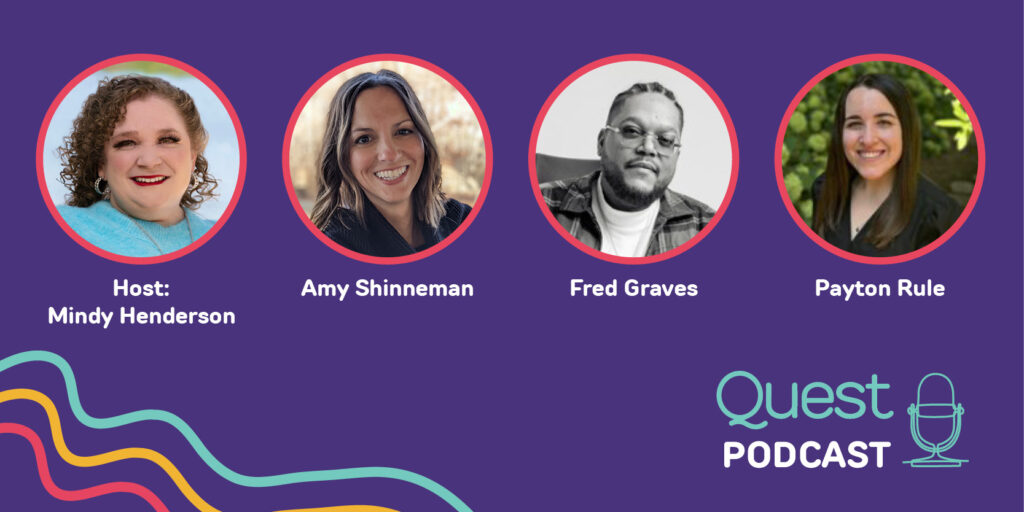
Learning to Manage the Grief of a Progressive Disease
By Barbara and Jim Twardowski, RN | Thursday, May 18, 2023
5 Second Summary
Living with a neuromuscular disease brings multiple losses. While grief is a normal reaction, taking steps to manage it can help you find joy and contentment in your life.
Whether coping with a recent diagnosis, adapting to a new loss of physical function, or mourning the life you had or hoped to have, grief can become overwhelming for those who have a neuromuscular disease.

Mary Holt-Paolone, MSRN, has helped people with neuromuscular diseases adjust to recurring losses
For nearly 20 years, Mary F. Holt-Paolone, MSRN, the Neurodegenerative Disease Program Coordinator at Temple University, has helped people with neuromuscular diseases adjust to recurring losses. “As their bodies change, they often feel uncomfortable about their feelings,” she says. “I try to stress that it is totally natural and understandable to have a whole range of emotions.”
A natural reaction to loss, grief is an acutely personal and complicated emotion. For individuals living with neuromuscular diseases, which tend to be progressive, managing grief can be a challenge. The depth and duration of grief vary from one person to another.
Personal story: Overcoming grief
Billy Zureikat played sports since he was a kid and worked in sports media for years as an ESPN radio producer in Chicago. “Sports was my life,” Billy says.
Around the age of 30, he started losing his balance and falling while playing basketball. At first, he thought it was part of getting older. But the number of falls increased while the muscle mass in his legs decreased.
“I was stubborn and scared, so I didn’t really look into it. I acted like nothing was wrong for a few years,” Billy says.
While vacationing in Paris, Billy struggled to climb the spiral staircase at the Notre Dame Cathedral and realized he couldn’t ignore the weakness in his legs anymore. As soon as he returned home, he saw a neurologist and underwent a barrage of testing but didn’t get a diagnosis.
Billy decided to push through by getting stronger. He hired a personal trainer, exercised regularly, and felt he was improving. Then, 2020 brought the pandemic and the gyms closed.
Without sports and exercise, Billy spent his free time honing another passion: cooking. He began making homemade pizzas and sharing them with friends. He became friends with a Chicago chef who tasted his creations and encouraged his efforts. Billy jokes he traded his jersey for an apron.

Billy Zureikat has made positive changes in his life since being diagnosed with limb-girdle muscular dystrophy.
Meanwhile, Billy was falling at least once a week, and he couldn’t climb stairs without grasping the railing. In February 2021, Billy fell and could not get up. He’d dislocated a joint in his foot and went to the emergency room. After hearing his medical history, the ER doctor referred him to a neurologist, who suggested he take a genetic test.
A week and a half later, Billy was diagnosed with limb-girdle muscular dystrophy (LGMD) at the age of 38.
After years of hiding that something was wrong, Billy was relieved to know what was causing his falls. He was also distressed to learn his condition is progressive and that there’s currently no treatment or cure.
“I was miserable,” he says. “During the first two months after my diagnosis, I was a shell of myself. I was stuck in the past, obsessing about what I couldn’t do anymore, missing sports.”
The staff at his MDA Care Center suggested therapy to help him cope with his emotions. “Everything began to change when I went to see a therapist,” says Billy, who had never before had counseling.
Two years after his diagnosis, Billy has not only accepted his disease, but has become a voice for the disability community. Combining his culinary skills with his media expertise, Billy has partnered with local Chicago restaurants that are serving his pizzas and other dishes to raise thousands of dollars for MDA. He has been the emcee for the Chicago MDA Muscle Walk and volunteers as an Illinois MDA Ambassador. Billy is working tirelessly to garner media coverage about his rare disease and the need for a cure.
“I have this disease, and I hate it. I wish I could go back right now and do things I did before,” he says. “But the disease has changed my life in a positive way, and I am proud. I’ve been able to cope differently. I’ve faced major adversity and turned it around.”
Billy, who is now 40, says, “I have a beautiful story, and I’ve barely scratched the surface of what I can do.” (Read more of Billy’s story on the Quest blog.)
Understanding grief
Each person grieves in their own unique way. Living with a chronic illness brings multiple and repetitive losses. Like a roller coaster, one will have highs and lows. And there’s no timetable for when grief will end.
Grief can disrupt sleeping patterns and affect appetite. Feeling irritable, distracted, tense, fearful, angry, or sad are common reactions to grief. Some people express their grief verbally, while some withdraw (not going out, avoiding talking with family and friends).
While grieving is a normal response to difficult circumstances, there is a point at which dwelling in the grief is not healthy.
“The goal is to intervene and find some freedom from the grief and replace it with some joy, or at least contentment,” Mary says.
4 ways to manage grief
An array of behaviors can help with processing grief.
- One highly recommended tool is journaling. Expressing your feelings through writing on a regular basis can be empowering. To get started, do an online search for grief journal prompts.
- Connecting with others is therapeutic. A recent study published in the journal Communication Research found that having a conversation once a day with a friend bolsters mental health. Try talking to someone with whom you feel safe sharing your emotions and experiences — it could be a family member, clergy member, friend, or peer with a similar condition. (Make friends through MDA’s Peer Connections and Let’s Play programs.)
- Giving yourself permission to have a good cry can be cathartic. Many people — especially men — have been taught crying is a sign of weakness. In fact, crying is a healthy coping mechanism and a powerful release of emotions.
- If possible, move your body. However large or small, intentional movement helps release the tension of unprocessed emotion that lingers in the body. Literally shaking things up can be a quick and effective way to improve your mood. Try these tips to get moving:
- Move through a simple stretch or yoga pose.
- Turn the music up and sing at the top of your lungs or dance.
- Take a meditative walk.
- Look for a home exercise or physical therapy program that works for you. MDA’s series of At-Home Physical Therapy Exercise guides for specific diseases can help.
Personal story: Adapting to life
Chris Anselmo learned he had LGMD after being in a car accident when he was 18. An irregular blood test was his only symptom. The doctors said he likely would not be affected by the disease until later in life, so he shoved the diagnosis to the back of his mind and enrolled in college.

Chris Anselmo found balance by acknowledging the great people and new opportunities in his life.
Five years later, after earning his degree and starting a new job, Chris noticed he could not run as far as he typically did. Within a year, he could only run for a few seconds, and he realized his declining athletic ability might be due to his disease.
Over the next 10 years, Chris’ muscles continued to weaken. He began to fall, and he could no longer climb stairs. Each change brought the introduction of a new mobility aid — leg braces, forearm crutches, a scooter, and then a wheelchair.
“I really struggled with processing what was going on and trying to adjust; it became so overwhelming,” Chris says. “I guess I grieved for the life I thought I was going to have and that my friends were having.”
Not a naturally rosy optimist, Chris’ initial reaction to living with his condition was denial. Accepting his new reality took him years.
Getting acquainted with others who had the same disease or used a wheelchair helped Chris envision a brighter future for himself. “There are people who have moved beyond the point where you are your disease,” he says. He met people with disabilities who were married, had careers, and even traveled the world.
Tired of obsessing over his losses, Chris decided to reorient his life. He spent a day making a list of what he could do, no matter his level of strength. This exercise showed him some of his goals were time-sensitive.
At the age of 29, Chris quit his job and enrolled in a full-time MBA program. He thought if he could successfully accomplish this difficult task, then more of his goals were possible as well.
Returning to school gave Chris newfound confidence. He tackled the challenge and earned his degree. The experience reminded him that he had wonderful people in his life — people he would not have gotten to know if he had not pursued advanced education at the time he did.
Chris eventually accepted a job offer with MDA and has continued to build a network of friends. He’s also been writing and speaking — opportunities he would not have pursued if he did not have a neuromuscular disease.
By embracing what is possible, Chris has forged a new path for himself on the road to acceptance. Living with LGMD is tough. Acknowledging the good parts of his life enables him to maintain a better balance.
“I think it’s healthy to have grief affect you — to mourn if you have lost the ability to walk or you need an assistive device or you can no longer play sports,” says Chris. “Everybody comes to their acceptance in their own time.”
“There’s nothing easy about losing an ability, but it can be managed. The loss does not have to take over your life. It doesn’t have to consume you,” says Chris. “Things are going to have to happen differently than you expected them to, but that’s not to say they can’t happen at all.” (Hear more of Chris’ story in the Quest Podcast episode “The Beginning: Receiving a Diagnosis.”)
Live in the moment
Chris experienced a common type of grief called “anticipatory grief,” which involves fixating on the future and mourning a future life one believes they have lost.
Another common aspect of grief is comparing the present to the past, as Billy did. But thinking too much about the past or the future can prolong grief. Staying in the present is beneficial.
A technique Mary teaches her clients is to use one of their five senses. For example: Stop whatever you are doing or thinking and just listen. Do you hear birds chirping outside an open window? Can you hear the fan spinning above your head? Focus on that sound.
Giving all your attention to one of your senses forces you to be in the moment.
“I’m an advocate for acknowledging, accepting, and processing,” Mary says. “That doesn’t have to take hours or days. It can actually take just a few moments to feel a feeling, acknowledge it is there, notice what it feels like in the body, be in that moment, and move forward.”
Everyone’s emotions vacillate throughout the day. But if you can’t stop thinking of your loss or lose interest in activities you used to enjoy, you may need assistance managing your grief. This might entail checking in with a counselor or joining a support group.
“Hopefully, people have compassion for themselves and realize it is okay to feel this way,” says Mary. “They need to know they are living incredibly extraordinary lives, and their feelings are normal.”
Next Steps and Useful Resources
- Find resources at MDA’s Mental Health Hubto support your mental health needs.
- The MDA Resource Center can provide information on finding specialized care at MDA Care Centers and mental health services. Call 833-ASK-MDA1or email resourcecenter@mdausa.org.
- Stay up-to-date on Quest content! Subscribe to Quest Magazine and Newsletter.
TAGS: Featured Content, Mental Health
TYPE: Featured Article
Disclaimer: No content on this site should ever be used as a substitute for direct medical advice from your doctor or other qualified clinician.




